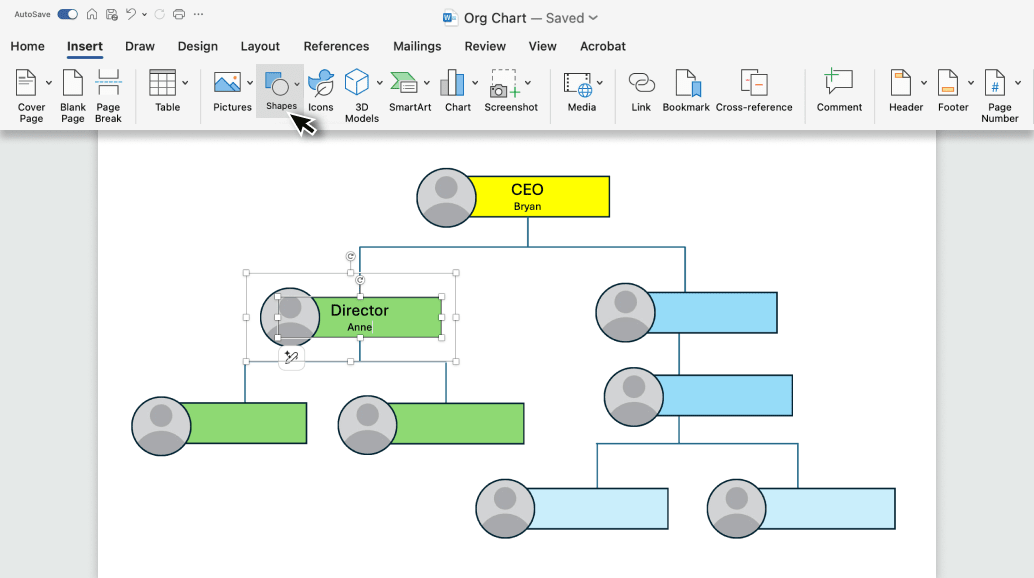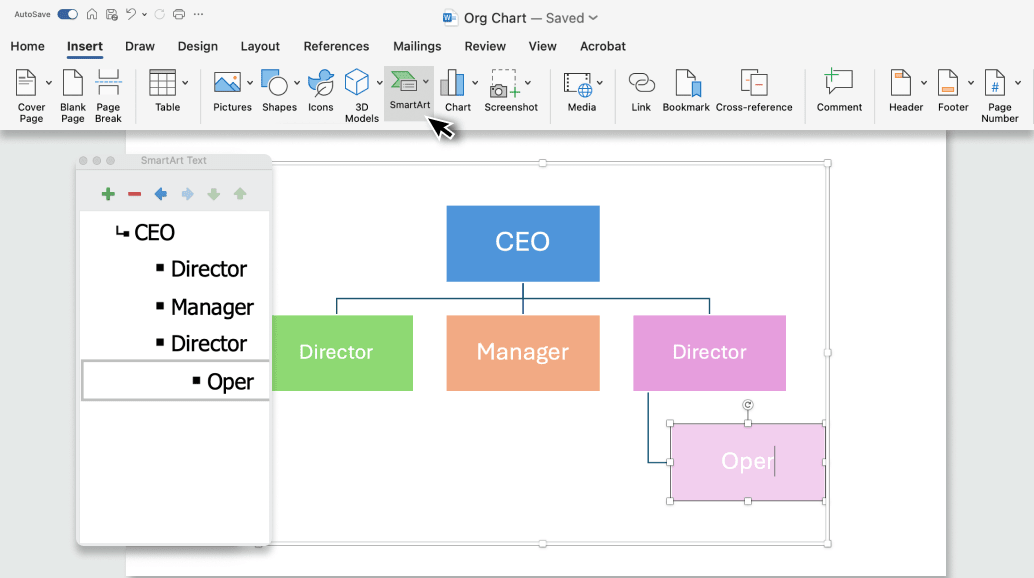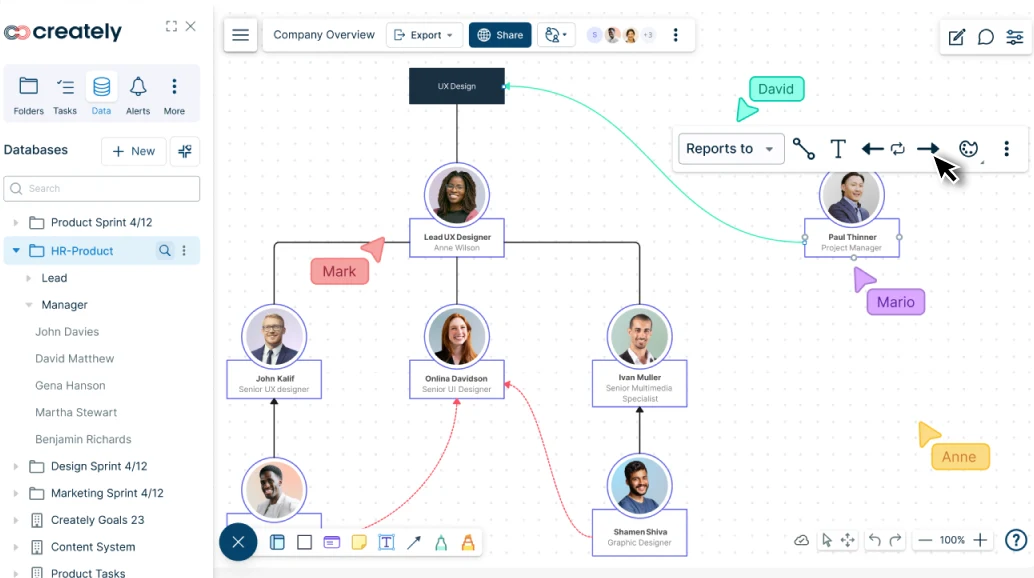Creating an organizational chart in Microsoft Word is a quick way to visualize reporting structures and team hierarchies without needing specialized software. Whether you’re preparing a presentation, documenting your company structure, or sharing team roles, Word’s built-in SmartArt graphics make it possible to create a simple org chart directly within your document. In this guide, we’ll walk you through the steps, share tips to make the process smoother, point out Word’s limitations, and explore a better alternative if you need more flexibility.
How to Make an Org Chart in Word Manually
Step 1: Open Word and Prepare Your Data
Open a blank Word document to start fresh. Create a simple table listing employee names, job titles, and supervisors. This structure will guide how you place roles in your chart.
Step 2: Insert Role Boxes
Go to the Insert tab, choose Shapes, and select rectangles (or rounded rectangles) to represent roles. Type the person’s name and job title directly inside each box.

Step 3: Duplicate and Arrange
Copy and paste the role boxes to create additional positions. Place the top-level role at the top and arrange subordinates below, forming clear levels of hierarchy.
Step 4: Connect with Lines
From the Shapes menu, insert elbow or straight connectors. Draw lines from managers to their direct reports to establish reporting relationships.
Step 5: Align and Format
Use the Align and Distribute options under the Drawing Tools tab to keep the chart neat. Apply colors, borders, and text styles to highlight departments or make the chart visually appealing. Group elements together to prevent them from shifting.
How to Draw an Organization Chart in Word Using SmartArt
Step 1: Insert a SmartArt Graphic
Open a new or existing Word document and go to the Insert tab on the ribbon. Click SmartArt, which opens a gallery of diagrams you can use. SmartArt provides built-in options that make it easy to create professional-looking visuals without manually drawing shapes.
Step 2: Choose the Hierarchy Layout
In the SmartArt gallery, scroll to the Hierarchy section. Here, you’ll find different org chart layouts, such as simple hierarchies or ones with additional assistant roles. Select the layout that best fits the structure of your organization, then click OK to add it to your document.

Step 3: Add and Edit Shapes for Roles
Once the SmartArt is inserted, you can customize it. Use the Add Shape button (under the SmartArt Design tab) to insert new positions. You can add shapes above, below, or next to an existing box depending on whether you’re adding a manager, a subordinate, or a colleague.
Step 4: Enter Employee Names and Titles
Click inside each box and type the person’s name, job title, or role. You can also use the Text Pane on the left-hand side to quickly add or edit names. This feature helps keep track of large structures without manually clicking each box.
Step 5: Format and Customize the Chart
After entering all the information, refine the look of your org chart. Use the SmartArt Styles and Colors options to apply consistent formatting, highlight departments with different colors, or change shapes and fonts for readability. Switching to Landscape orientation in Page Layout can also make wider charts easier to read.
Step 6: Share the Org Chart
Once your chart is ready, you can share it by saving the Word document or exporting it. Go to File and Click Save As to save a copy in Word or PDF format for easy distribution. You can also copy the chart and paste it into a PowerPoint presentation or an email. For collaborative updates, save the file to a shared drive (like OneDrive or Google Drive) so others can view or edit it.
Tips for Building MS Word Org Charts
Use consistent titles and naming conventions: Stick to a clear format for job titles and names (e.g., “John Smith – Marketing Manager”) to keep the chart professional and easy to read.
Keep the hierarchy simple to avoid clutter: Avoid overloading the chart with too many details. Focus on key roles and reporting lines so the structure remains clear.
Use colors and styles for departments or teams: Applying different colors or styles helps group related roles together and makes it easier to distinguish between teams at a glance.
Zoom out or use landscape orientation for larger charts: Large org charts can get cramped in portrait view. Switching to landscape orientation or zooming out ensures everything fits neatly on the page.
Limitations of Creating Org Charts in Word
Limited design flexibility: Word’s SmartArt tools offer only basic customization, making it hard to create highly polished or unique org charts.
Difficult to manage large or complex organizational structures: As the chart grows, arranging and resizing boxes becomes cumbersome, and the layout can quickly get messy.
Updating charts can be time-consuming: Every time a role changes, you need to manually adjust the boxes and connections, which is inefficient for frequently changing organizations.
Not ideal for real-time collaboration: Word documents are not designed for multiple people to edit and update simultaneously, limiting teamwork on org chart creation.
Create Org Charts with Creately – Word Alternative
Let’s go through how to create the org chart much faster using Creately.
Step 1: Begin with a Template or Blank Workspace
Launch Creately and either pick an org chart template from the library or start fresh on a blank canvas. Templates help you get started quickly, while a blank workspace gives you complete creative freedom.
Step 2: Import Data or Add Roles Manually
Skip the hassle of creating everything from scratch by importing a CSV file containing employee names, job titles, and supervisors. Creately automatically generates the hierarchy for you. Alternatively, you can draw roles individually using shapes.

Step 3: Build the Reporting Structure
Imported charts in Creately come with connections already in place. If you’re adding roles manually, use smart connectors to link managers and their direct reports. These connectors adjust automatically when roles are moved, keeping the chart organized.

Step 4: Personalize Your Org Chart
Enhance readability by applying colors, tags, or even profile photos. Use color-coding to distinguish departments, mark vacant positions, or highlight key roles for clarity.
Step 5: Collaborate and Insert in Word
Work together with your team in real time by adding comments, notes, or attachments for context. When it’s time to share, you can export your chart as an image or PDF and insert it into a Word document or Powerpoint Slide.
Why Creately is the Better Alternative for Org Charts
Instead of struggling with Word’s limited SmartArt features, you can use Creately which is built specifically for visual collaboration. It can make it much easier to design, update, and share organizational charts.
Auto-generate Org Charts: Import data from spreadsheets or HR systems to automatically generate and update org charts. This ensures accuracy and saves hours of manual work whenever your team structure changes.
Dynamic org chart views: Ensure your charts always stay current. Link them to employee databases so any changes to roles, titles, or team structures are instantly reflected across all org charts without extra manual effort.
Ready-made templates: Start quickly with pre-designed org chart templates that you can customize to fit your organization. Templates cover common structures, saving you from starting with a blank page.
Drag-and-drop design: Easily add, move, or rearrange roles without manually fixing the layout. Smart connectors and auto-alignment keep everything neat as you adjust positions.
Scalability: Handles large or complex organizational structures without the chart becoming cluttered or unmanageable. Infinite canvas and zooming options make it easy to navigate big orgs.
Real-time collaboration: Multiple team members can edit and update the chart simultaneously. Comment, @mention teammates, and track changes so everyone stays aligned.
Presentation Mode: Instantly switch to a clean, full-screen view to present your org chart during meetings. Highlight key teams or roles without needing to export slides separately.
Data Rich Nodes: Attach employee details, documents, or links directly to each role box. This turns your org chart into a central hub for team information, making it more than just a visual hierarchy.
Free Org Chart Templates from Creately
Helpful Resources for Making Org Charts
Learn the basic rules of making org charts and best practices to make them effective.
Learn all the steps in how to create an organization chart in Powerpoint.
Discover the org chart diagram templates that can help visualize your organization.
FAQs about Creating Org Charts in Word
Can I create an MS Word org chart without SmartArt?
How do I add more boxes to my organization chart in Word?
Is Word suitable for large org charts?
What if my MS Word org chart doesn’t fit on one page?
Resources
Bannon, Joseph J. “The Organizational Chart: The Manager’s Toy.” Journal of Physical Education, Recreation & Dance, vol. 53, no. 4, Apr. 1982, pp. 47–48, https://doi.org/10.1080/07303084.1982.10631093.
Tropman, John E. “The Organizational Circle”: Administration in Social Work, vol. 13, no. 1, 13 Mar. 1989, pp. 35–44, https://doi.org/10.1300/j147v13n01_03.





